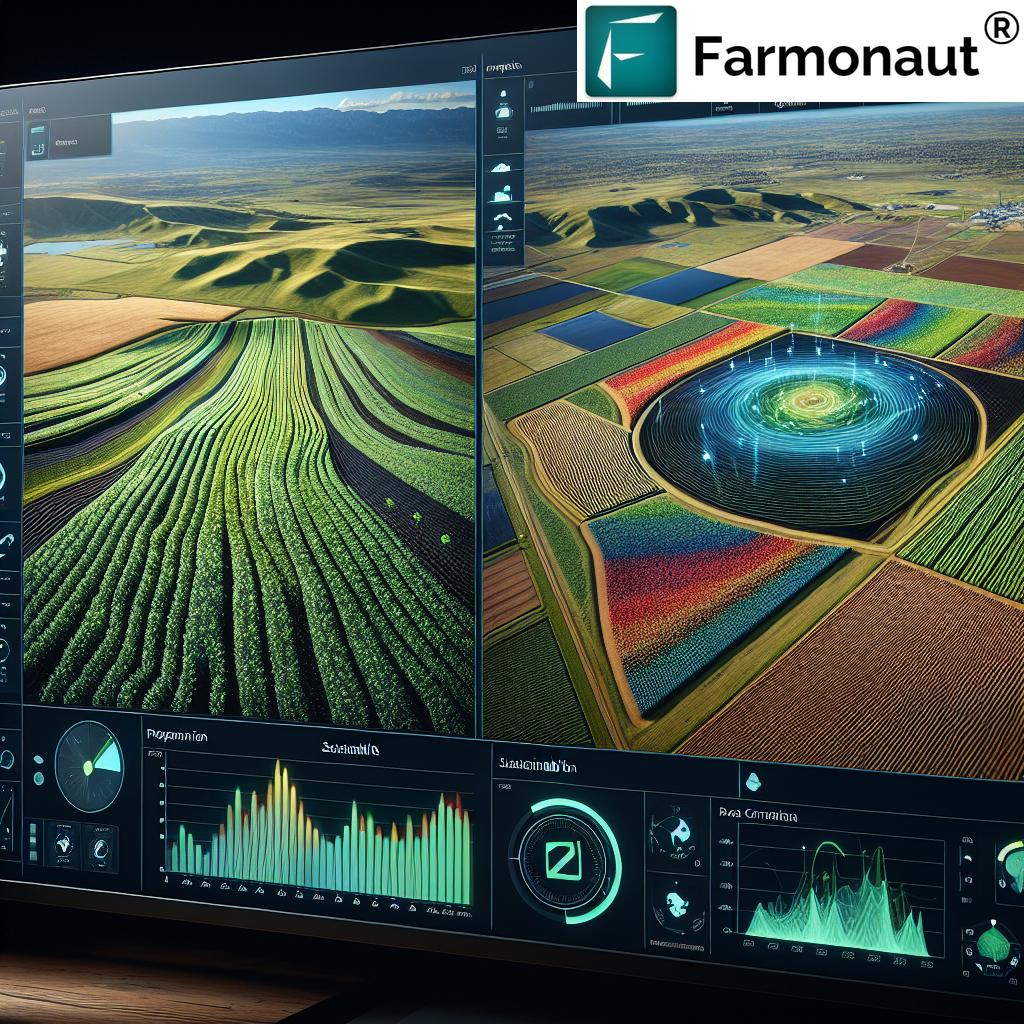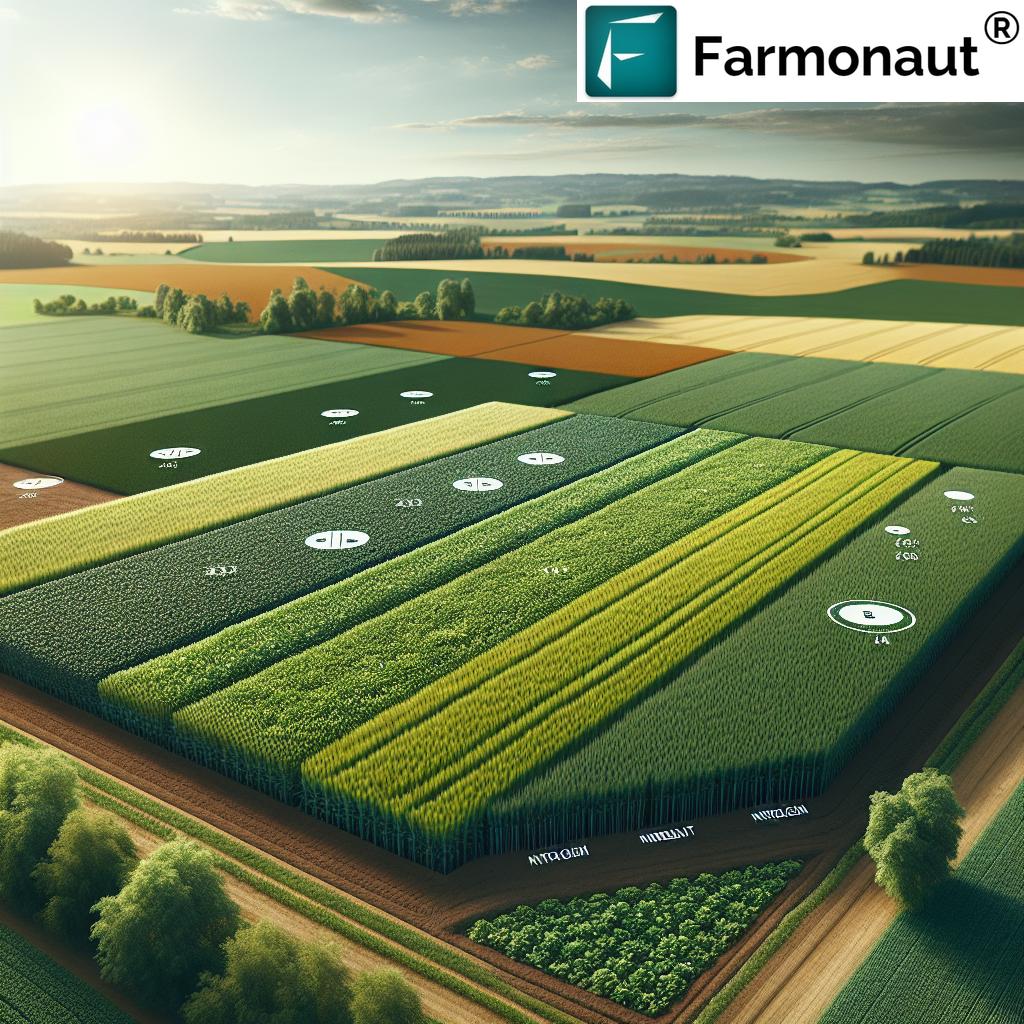Revolutionizing Precision Agriculture: How Yield Monitoring and Mapping Boost Crop Performance and Sustainability
“Yield monitoring systems can increase crop productivity by up to 10% through precise field management and data-driven decision making.”
In the ever-evolving landscape of modern agriculture, we find ourselves at the forefront of a technological revolution that’s reshaping the way we grow food, manage resources, and sustain our planet. At the heart of this transformation lies precision agriculture, with yield monitoring and mapping playing pivotal roles in boosting crop performance and fostering sustainability. In this comprehensive exploration, we’ll delve into how these innovative technologies are revolutionizing farming practices, empowering growers with data-driven insights, and paving the way for a more efficient and environmentally conscious agricultural future.

The Evolution of Farming: From Traditional Methods to Precision Agriculture
To truly appreciate the impact of yield monitoring and mapping, we must first understand the journey from traditional farming methods to the data-driven approaches of today. For centuries, farmers relied on intuition, generational knowledge, and basic tools to manage their crops. While these methods served us well, they often resulted in inefficiencies, inconsistent yields, and environmental challenges.
The advent of precision agriculture has ushered in a new era of farming, one where technology and data play central roles in decision-making processes. This shift has been driven by several key factors:
- Advancements in GPS technology
- Development of sophisticated sensors and IoT devices
- Improved satellite imaging capabilities
- Progress in data analytics and machine learning
- Growing environmental concerns and the need for sustainable practices
These technological advancements have converged to create powerful tools for yield monitoring and mapping, enabling farmers to make informed decisions about every aspect of their operations, from seed selection to harvest timing.
Understanding Yield Monitoring in Precision Agriculture
Yield monitoring is a cornerstone of precision agriculture, providing farmers with real-time data on crop productivity across their fields. This technology allows for the collection of detailed information about crop yields during harvest, creating a comprehensive picture of field performance.
Key components of yield monitoring systems include:
- Yield sensors: Installed on harvesting equipment to measure grain flow
- GPS receivers: To precisely locate yield data points within the field
- Moisture sensors: To account for variations in crop moisture content
- Data storage and processing units: To collect and analyze yield information
By integrating these components, yield monitoring systems offer several benefits:
- Accurate yield measurement and mapping
- Identification of high and low-yielding areas within fields
- Assessment of the effectiveness of different management practices
- Data-driven decision-making for future crop planning
Crop Yield Mapping Techniques: Visualizing Field Performance
Crop yield mapping takes the data collected through yield monitoring and transforms it into visual representations of field productivity. These maps provide invaluable insights into spatial variability across agricultural lands, allowing farmers to make targeted decisions about resource allocation and management practices.
Common yield mapping techniques include:
- Point-based mapping: Creating yield maps based on individual data points collected during harvest
- Interpolation methods: Using algorithms to estimate yield values between measured points
- Remote sensing integration: Combining yield data with satellite or drone imagery for enhanced analysis
- Multi-year mapping: Comparing yield maps across seasons to identify consistent patterns or anomalies
These techniques enable farmers to:
- Visualize yield variations across their fields
- Identify areas that consistently underperform or overperform
- Correlate yield patterns with other factors such as soil type, topography, or management practices
- Make informed decisions about variable rate applications of inputs
Explore Farmonaut’s advanced crop monitoring and yield prediction capabilities through our user-friendly web app.

The Benefits of Yield Data Analysis in Modern Farming
The wealth of data generated through yield monitoring and mapping opens up a world of possibilities for farmers and agronomists. By leveraging advanced analytics tools, we can extract valuable insights that drive improvements in crop performance, resource efficiency, and overall farm profitability.
Key benefits of yield data analysis include:
- Optimized input application: Tailoring fertilizer, pesticide, and water use to specific field zones
- Improved crop selection: Choosing varieties best suited to different areas of the farm
- Enhanced decision-making: Basing management choices on historical yield data and trends
- Increased operational efficiency: Streamlining harvesting and other field operations
- Better risk management: Identifying and addressing yield-limiting factors proactively
“Advanced GPS technology in precision agriculture can map field variations with accuracy down to 1 centimeter, optimizing resource allocation.”
Precision Farming Technologies: Beyond Yield Monitoring
While yield monitoring and mapping form the foundation of precision agriculture, a suite of complementary technologies further enhances farm management capabilities. These technologies work in concert to provide a comprehensive approach to precision farming:
- Variable Rate Technology (VRT): Allows for precise application of inputs based on yield maps and other data
- Soil Sensing: Provides detailed information about soil composition, moisture, and nutrient levels
- Drone and Satellite Imaging: Offers real-time crop health assessments and early problem detection
- Weather Stations: Deliver hyperlocal climate data for improved decision-making
- IoT Sensors: Monitor various environmental and crop parameters in real-time
By integrating these technologies with yield monitoring and mapping systems, farmers can create a holistic approach to precision agriculture that addresses every aspect of crop production.
Variable Rate Fertilization: Precision Nutrient Management
One of the most significant applications of yield mapping in precision agriculture is variable rate fertilization. This approach allows farmers to apply fertilizers at varying rates across their fields, matching nutrient application to crop needs and soil conditions.
Benefits of variable rate fertilization include:
- Improved nutrient use efficiency
- Reduced environmental impact from excess fertilizer runoff
- Optimized crop yields across the entire field
- Cost savings through more efficient use of inputs
By combining yield maps with soil test results and other data sources, farmers can create precise fertilization plans that maximize productivity while minimizing waste and environmental impact.
Sustainable Farm Management Through Data-Driven Decisions
The integration of yield monitoring and mapping into farm management practices isn’t just about increasing productivity—it’s also a crucial step towards more sustainable agriculture. By providing detailed insights into field performance and resource use, these technologies enable farmers to make environmentally conscious decisions without sacrificing yields.
Key aspects of sustainable farm management through precision agriculture include:
- Reduced input use: Applying fertilizers, pesticides, and water only where and when needed
- Soil conservation: Identifying areas prone to erosion or compaction for targeted management
- Biodiversity preservation: Optimizing land use to leave room for natural habitats
- Carbon footprint reduction: Minimizing unnecessary field operations and fuel consumption
- Water management: Implementing precision irrigation based on yield potential and soil moisture data
Discover how Farmonaut’s satellite-based solutions can enhance your sustainable farming practices. Download our mobile app for on-the-go farm management:


Agricultural Data Visualization: Making Sense of Complex Information
The power of yield monitoring and mapping lies not just in data collection, but in how that data is presented and interpreted. Agricultural data visualization tools play a crucial role in transforming raw yield data into actionable insights.
Effective data visualization in precision agriculture:
- Simplifies complex datasets for easier interpretation
- Highlights trends and patterns that might be missed in raw data
- Enables quick decision-making based on visual cues
- Facilitates communication between farmers, agronomists, and other stakeholders
Modern agricultural platforms, like Farmonaut, offer sophisticated visualization tools that allow farmers to interact with their data in meaningful ways, from 3D yield maps to time-lapse animations of crop health throughout the growing season.
Crop Performance Optimization: Leveraging Yield Data for Maximum Productivity
The ultimate goal of yield monitoring and mapping is to optimize crop performance across entire farming operations. By analyzing yield data in conjunction with other factors such as weather patterns, soil conditions, and management practices, farmers can develop strategies to maximize productivity in every part of their fields.
Key strategies for crop performance optimization include:
- Identifying and addressing yield-limiting factors in specific field zones
- Fine-tuning planting densities based on yield potential
- Optimizing crop rotations to maintain soil health and break pest cycles
- Implementing precision irrigation to match water application to crop needs and field conditions
- Adapting management practices to account for microclimates within the farm
By continuously refining these strategies based on yield data and other insights, farmers can achieve steady improvements in crop performance year after year.
Field Variability Assessment: Understanding Your Land
One of the most valuable aspects of yield monitoring and mapping is the ability to assess field variability in detail. This understanding allows farmers to move beyond a one-size-fits-all approach to crop management and instead tailor their practices to the specific needs of different areas within their fields.
Key factors in field variability assessment:
- Soil type and composition
- Topography and drainage patterns
- Microclimate variations
- Historical management practices
- Pest and disease pressure
By overlaying yield maps with other data layers, such as soil surveys or satellite imagery, farmers can gain a comprehensive understanding of the factors influencing crop performance across their land.

Precision Irrigation Management: Water Efficiency through Data
Water management is a critical aspect of modern agriculture, particularly in regions facing water scarcity or unpredictable rainfall patterns. Yield monitoring and mapping play a crucial role in optimizing irrigation practices, ensuring that water is applied efficiently and effectively across the field.
Benefits of precision irrigation management include:
- Reduced water consumption and associated costs
- Improved crop health and yield potential
- Minimized risk of water-related stress or disease
- Enhanced environmental stewardship through responsible water use
By integrating yield data with soil moisture sensors, weather forecasts, and crop water demand models, farmers can create highly precise irrigation schedules that maximize water use efficiency while supporting optimal crop growth.
The Role of Agtech in Shaping the Future of Farming
As we look to the future of agriculture, it’s clear that agtech solutions like yield monitoring and mapping will play an increasingly central role in farm management. These technologies are not just tools for increasing productivity; they’re catalysts for a more sustainable, efficient, and resilient agricultural sector.
Key trends in agtech that complement yield monitoring and mapping:
- Artificial Intelligence and Machine Learning for predictive analytics
- Blockchain technology for improved traceability and supply chain management
- Robotics and automation for precision field operations
- Edge computing for real-time data processing and decision-making
- 5G connectivity for seamless data transfer and remote management
As these technologies continue to evolve and integrate, we can expect to see even greater advancements in precision agriculture, further enhancing our ability to produce food sustainably and efficiently.
Leverage Farmonaut’s cutting-edge agtech solutions through our comprehensive API. For detailed integration guidance, consult our API Developer Docs.
Comparing Traditional and Precision Agriculture Practices
To fully appreciate the impact of yield monitoring and mapping, let’s compare traditional farming methods with precision agriculture approaches:
| Agricultural Practice | Traditional Method | Precision Agriculture Approach | Benefits of Precision Approach |
|---|---|---|---|
| Fertilizer Application | Uniform application across fields | Variable rate application based on yield maps and soil tests | 25% reduction in fertilizer costs, improved nutrient efficiency |
| Irrigation Management | Scheduled watering based on general crop needs | Precision irrigation using soil moisture sensors and yield potential data | 20% reduction in water usage, optimized crop hydration |
| Pest Control | Blanket application of pesticides | Targeted pest management using yield data and pest pressure maps | 30% reduction in pesticide use, decreased environmental impact |
| Soil Health Monitoring | Periodic soil sampling on a field-wide basis | Continuous monitoring with IoT sensors and yield map correlation | Improved soil quality, 15% increase in organic matter over time |
| Yield Prediction | Estimates based on historical averages | AI-driven predictions using multi-year yield data and real-time crop health information | 90% accuracy in yield forecasts, improved market planning |
Challenges and Considerations in Implementing Yield Monitoring and Mapping
While the benefits of yield monitoring and mapping are clear, implementing these technologies can present challenges for some farmers. It’s important to consider these factors when adopting precision agriculture practices:
- Initial investment costs for equipment and software
- Learning curve associated with new technologies
- Data management and interpretation challenges
- Integration with existing farm management systems
- Ensuring data privacy and security
Despite these challenges, the long-term benefits of yield monitoring and mapping often outweigh the initial hurdles, leading to improved profitability and sustainability for farms of all sizes.
The Future of Yield Monitoring and Mapping
As technology continues to advance, we can expect to see even more sophisticated yield monitoring and mapping capabilities. Some exciting developments on the horizon include:
- Real-time yield monitoring with instant data analysis and recommendations
- Integration of yield data with global market trends for optimized crop planning
- Advanced predictive modeling using AI and machine learning algorithms
- Seamless integration of yield data across the entire agricultural value chain
- Enhanced 3D visualization tools for more intuitive data interpretation
These advancements will further empower farmers to make data-driven decisions that optimize crop performance, resource efficiency, and overall farm profitability.
Conclusion: Embracing the Precision Agriculture Revolution
Yield monitoring and mapping have revolutionized precision agriculture, providing farmers with unprecedented insights into their fields and crops. By leveraging these technologies, we can boost crop performance, enhance sustainability, and ensure the long-term viability of our agricultural systems.
As we move forward, the integration of yield monitoring and mapping with other advanced agtech solutions will continue to transform farming practices, driving us towards a future of smarter, more efficient, and more sustainable agriculture. By embracing these innovations, we can meet the growing global demand for food while preserving our precious natural resources for generations to come.
The journey towards fully optimized precision agriculture is ongoing, but with tools like yield monitoring and mapping at our disposal, we’re well-equipped to face the challenges and opportunities that lie ahead in the world of modern farming.
FAQs
- What is yield monitoring in precision agriculture?
Yield monitoring is the process of collecting detailed data about crop productivity during harvest using sensors and GPS technology. It provides real-time information on crop yields across different areas of a field. - How does yield mapping differ from yield monitoring?
Yield mapping takes the data collected through yield monitoring and creates visual representations of field productivity. These maps allow farmers to see spatial variations in yield across their fields. - What are the main benefits of using yield monitoring and mapping?
Key benefits include optimized input application, improved crop selection, enhanced decision-making, increased operational efficiency, and better risk management. - How does yield data analysis contribute to sustainable farming?
Yield data analysis enables more precise resource management, reducing waste and environmental impact. It allows farmers to apply inputs only where needed, conserve soil, and implement more sustainable practices. - What technologies complement yield monitoring and mapping in precision agriculture?
Complementary technologies include variable rate technology (VRT), soil sensing, drone and satellite imaging, weather stations, and IoT sensors. - How can small-scale farmers benefit from yield monitoring and mapping?
Small-scale farmers can benefit through improved resource allocation, better understanding of their fields, and data-driven decision-making that can lead to increased yields and reduced input costs. - What challenges might farmers face when implementing yield monitoring and mapping?
Challenges can include initial investment costs, a learning curve for new technologies, data management and interpretation, and integration with existing farm systems. - How is AI being integrated into yield monitoring and mapping systems?
AI is being used for predictive analytics, automated data interpretation, and creating more sophisticated yield prediction models based on historical and real-time data. - Can yield monitoring and mapping help with climate change adaptation in agriculture?
Yes, these technologies can help farmers adapt to changing climate conditions by providing detailed insights into field performance under various weather patterns, enabling more resilient farming practices. - How does Farmonaut support yield monitoring and mapping efforts?
Farmonaut provides advanced satellite-based farm management solutions that complement yield monitoring efforts, offering real-time crop health monitoring, AI-based advisory systems, and powerful data visualization tools to help farmers make informed decisions.










